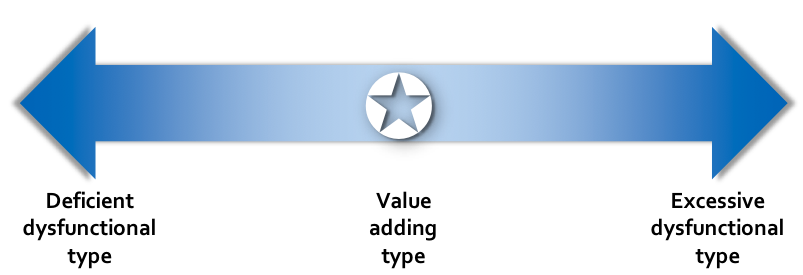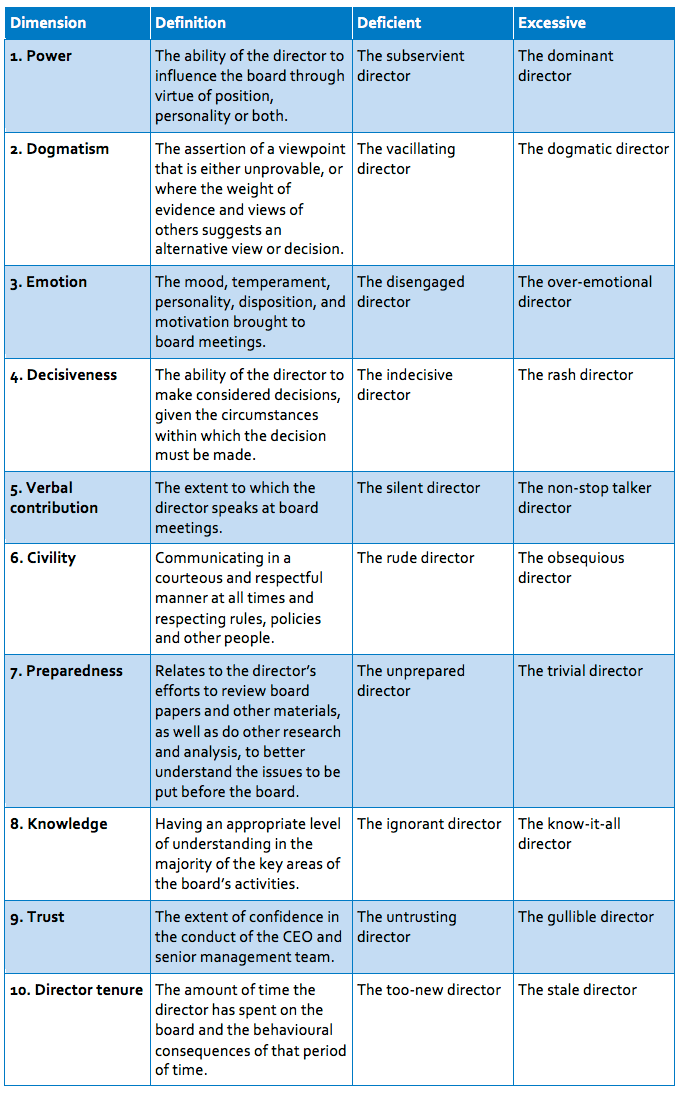board-dynamics
What is Your Director Personality?
Published: July 7, 2014
Read Time: 5 minutes

There is a growing understanding that board behavioural dynamics are a central driver in producing strong organisational outcomes.
Every board will demonstrate different behavioural dynamics. These differences are both between boards and within the one board over time. However, boardroom dynamics is often a difficult area for boards to address when they go awry.
Four important drivers impact board behavioural dynamics:
- The specific issues facing the board at the moment;
- The impact of both the organisational and board cultures;
- The individual personalities of the chair and the CEO and how their personalities interact;
- The personalities of the directors and, to a lesser extent, the roles and personalities of the company secretary and members of the senior management team such as the chief financial officer.
This article looks at director personality and makes suggestions for what you and your board can do to address the types of dysfunctional directors you may encounter in the boardroom.
What is your director personality?
There is a significant collection of literature available on personality in general and what may be termed management personality – the behaviour of managers in the workplace. Yet, very little has been written on the specific personality characteristics of directors. To address this, my colleagues and I have hypothesised 10 key dimensions of what may be termed ‘director personality’. For each of these 10 director personality dimensions, we identify the specific behaviours that can cause dysfunction on any board.
The 10 dimensions come from well-entrenched concepts from psychology such as dominance and emotion, as well as some concepts that are specific to boards such as preparedness. Each of the 10 dimensions has two extremes, each of which represents dysfunctional behaviour. Consequently, the two ends are polar opposites of each other. A dysfunctional director may display either too little or too much of the behaviour associated with each dimension of the director personality. A director with appropriate behaviours will be in the centre range of the dimension (see Figure 1). For example, on the power dimension, which concerns the extent to which one director can exert power over other directors, value adding directors have the ability to influence the rest of the board through good insight and argument, are listened to and command respect without seeking to dominate other directors.

Table 1 outlines the deficient and excessive dysfunctional types for each of the 10 dimensions. Examples of either dysfunctional type can have a damaging impact on board behavioural dynamics, although sometimes to varying degrees. Under this classification, it is possible for a director to exhibit more than one dysfunctional type. For example, dominant directors (see power dimension) are often rude, both inside and outside the boardroom. These boardroom bullies can cause other directors to stop speaking up at meetings, because they feel their insights are not valued.
Table 1: The dysfunctional director personality types

As an example of dysfunctional directors; under the ‘decisiveness’ dimension, both the ‘indecisive’ director (deficient dysfunctional type) and the ‘rash’ director (excessive dysfunctional type) are equally problematic in the boardroom when it comes to decision-making, but for different reasons and with different outcomes. The indecisive director will not be able to make a decision without spending considerable time poring over alternatives, meaning the organisation could miss a valuable opportunity; whereas the rash director will not sufficiently weigh up the pros and cons, meaning the board could make an unwise investment.
Dealing with dysfunction
In many cases, alerting a director to the dysfunctional behaviour they are exhibiting can bring about significant change to that behaviour. However, not all directors have the self-awareness to do so and there are three major categories of tools that board can use to deal with dysfunctional directors:
- Board codes of conduct.
- Board evaluations including individual director evaluation.
- Director development.
The first tool is a board-specific code of conduct, which sets out the agreed expectations of the board in a variety of areas relevant to behaviours and relationships. Codes of conduct have the benefit of establishing written norms of behaviour and provide a reference to which directors can refer if they believe that certain behaviours are dysfunctional.
Another important tool to guard against dysfunctional behaviours is the board evaluation. For example, the evaluation process can include questions regarding group and individual contributions, behaviours and relationships, which will help to illuminate any issues in the boardroom and provide a mechanism for beginning a dialogue about how to resolve those issues. It should be noted however that if poorly executed, a board evaluation can lead to distrust among board members and between the board and management.
Evaluating individual director performance can often bring significant benefit to the board-as-a-whole evaluation process and can take the form of either self or peer evaluation. Peer-driven individual director evaluations are an especially useful tool to indicate to dysfunctional directors the negative impact their behaviour is having. In cases where the person lacks the emotional intelligence to change their behaviour, seeking their removal from the board may be the only viable option.
Finally, boards can also invest in director development. In the past, boards have focused on new member induction. However, as directors’ responsibilities have become increasingly sophisticated, the scope and frequency of training and professional development programs for directors have expanded in turn to meet the corresponding needs of boards. Areas that require strengthening are likely to emerge from full board or individual director evaluations, and can then be built into a training program. That may mean sessions on topics for the entire board to attend or an outside session on a specific topic for an individual director.
Conclusion
Boardroom dynamics is fundamental to good governance and has become an increasingly important topic for consideration by boards. Directors cannot fulfil their responsibilities in a boardroom where a few dysfunctional directors are allowed to poison the atmosphere or interfere with board decision making. The challenge for boards and their leaders is to manage the behavioural complexity that is involved in a decision-making group such as a board. This article has addressed the issue of director personality, offered suggestions as to how boards may identify dynamics issues and also outlined the steps to take to improve their own boardroom dynamics.
Share this Article
Recommended Reading
Recommended Viewing
Author
-
Ex-Managing Director
Effective Governance
- About
-
At the time of writing James was Managing Director of Effective Governance, an advisory firm that provides expertise and assistance on corporate governance, strategy and risk in Australia and New Zealand to a wide variety of clients including public and private companies, not-for-profit organisations, associations, co-operatives and government owned corporations.
Found this article useful or informative?
Join 5,000+ not-for-profit & for-purpose directors receiving the latest insights on governance and leadership.
Receive a free e-book on improving your board decisions when you subscribe.
Unsubscribe anytime. We care about your privacy - read our Privacy Policy .







